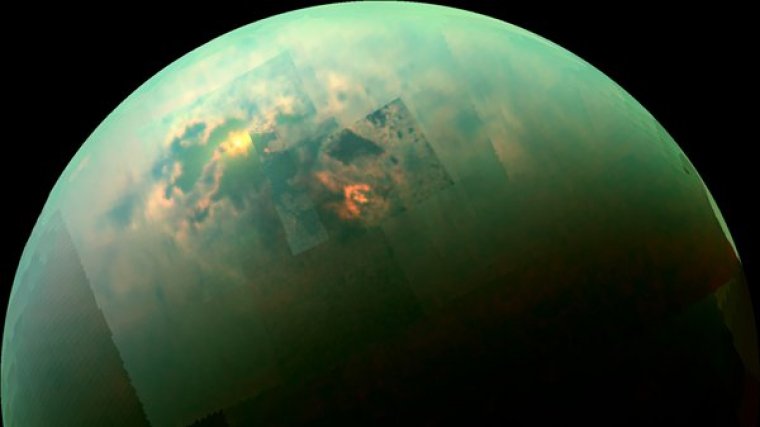| News / Space News |
Cassini Explores a Methane Sea on Titan
NASA | APRIL 28, 2016
A new study finds that a large sea on Saturn's moon Titan is composed mostly of pure liquid methane, independently confirming an earlier result.

Sunlight glints off of Titan's northern seas this near-infrared, color mosaic from NASA's Cassini spacecraft. ![]()
The Cassini spacecraft has revealed that more than 620,000 square miles (1.6 million square kilometers) of Titan's surface -- almost two percent of the total -- are covered in liquid.
There are three large seas, all located close to the moon's north pole, surrounded by numerous of smaller lakes in the northern hemisphere. Just one large lake has been found in the southern hemisphere.
The exact composition of these liquid reservoirs remained elusive until 2014, when the Cassini radar instrument was first used to show that Ligeia Mare, the second largest sea on Titan and similar in size to Lake Huron and Lake Michigan combined, is methane-rich.
Either Ligeia Mare is replenished by fresh methane rainfall, or something is removing ethane from it. It is possible that the ethane ends up in the undersea crust, or that it somehow flows into the adjacent sea, Kraken Mare, but that will require further investigation.
During the 2013 experiment, the radar instrument detected echoes from the seafloor and inferred the depth of Ligeia Mare along Cassini's track over Ligeia Mare -- the first-ever detection of the bottom of an extraterrestrial sea. The scientists were surprised to find depths in the sea as great as 525 feet (160 meters) at the deepest point along the radar track. The seabed of Ligeia Mare is likely covered by a sludge layer of organic-rich compounds.
In the atmosphere of Titan, nitrogen and methane react to produce a wide variety of organic materials. Scientists believe the heaviest materials fall to the surface. The insoluble compounds, such as nitriles and benzene, sink to the sea floor.
YOU MAY ALSO LIKE



